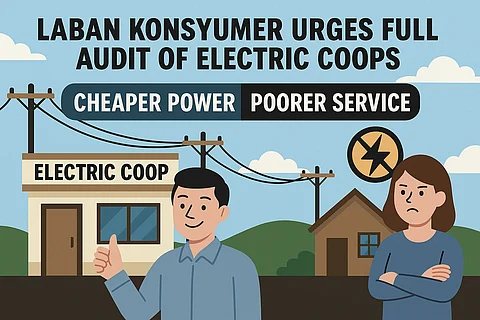
- NEWS
- the EDIT
- COMMENTARY
- BUSINESS
- LIFE
- SHOW
- ACTION
- GLOBAL GOALS
- SNAPS
- DYARYO TIRADA
- MORE

Laban Konsyumer Inc. (LKI) has called on the National Electrification Administration (NEA) to release a comprehensive and transparent analysis of the country’s electric cooperatives, including their full service records and performance data.
The group said comparing these cooperatives to major private distributors such as Meralco is like “comparing apples to oranges,” as many rural areas still suffer from unreliable electricity despite supposedly lower rates.
"This is to determine whether these electric cooperatives have been delivering quality service and supplying enough electricity to their customers 24/7 with at least minimal or close to no interruption service," LKI said in a statement.
While acknowledging that some electric cooperatives may offer lower power rates, LKI stressed that consumers deserve not just affordability but also substantial, sustainable, and adequate service.
"That is why the functions of the Department of Energy and the Energy Regulatory Commission are vital to the consumers — they should be balancing the cost and services these distribution facilities are providing," the group said.
The call comes amid persisting gaps in electricity access across the country. Citing a working paper published in September 2019 by Shinichi Taniguchi for the Asian Development Bank (ADB), LKI pointed to the large discrepancy in electrification rates between urban centers and rural areas.
In Metro Manila and other key cities served by Meralco, electricity access stands at around 98 percent. But in many remote areas — particularly in Mindanao — access rates remain as low as 40.9 percent, based on Department of Energy (DOE) data cited in the report.
"Electricity supply is often short," the report noted, underscoring challenges in rural electrification that continue to this day.
"It must be unfair for the other distribution facilities to be compared with electric cooperatives that offer mediocre services," LKI said, adding that many private utilities invest heavily in infrastructure, reserve power, and disaster-resilient systems.
"These are not cheap, but will definitely bring stability in consumer electricity especially during calamities," the group added.
LKI slammed what it described as "half-truths" being presented by the NEA and demanded the release of updated data on rural electrification — a program that started in the 1960s.
The group is asking NEA to disclose key indicators such as system losses, financial performance, and reliability of service among the electric cooperatives operating under its supervision.
“Instead of coming out with ‘half-truths,’ NEA should release the update on rural electrification that started as early as 1960s — a full comparative analysis, not just electricity rates, but also key service reliability indicators,” it said.
The group reiterated its call for transparency and accountability in the power sector, urging the NEA to focus on its core mandate of ensuring reliable, affordable, and efficient electricity service to all Filipinos.
LKI emphasized that Filipino consumers are willing to pay fair rates for electricity, but only if the service is consistent and up to standard.
“Consumers prefer cheaper cost of electricity; however, electric service must also be substantial, adequate, and sustainable,” the group said.
